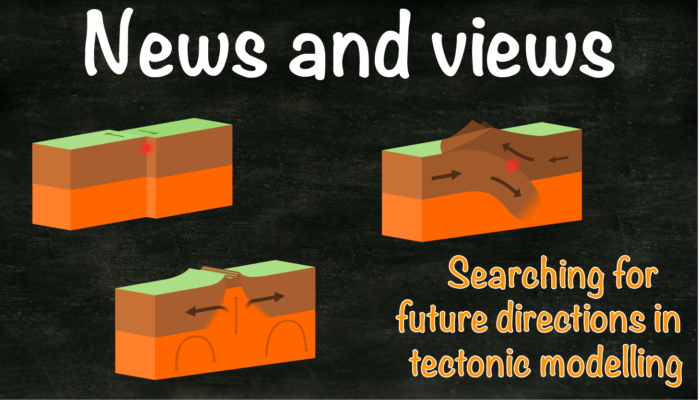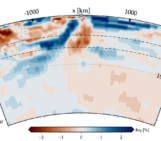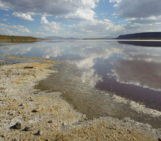
Geoscientists frequently use forward geodynamic simulations to test hypotheses derived from geophysical and geologic observations. While numerical simulations of lithospheric deformation have lead to key advances in our understanding of tectonic processes, in many cases it remains difficult to ascertain whether numerical models reproduce observations for the correct underlying regions. This week, John Naliboff and Jolante van Wijk discuss this issue, and talk about a White Paper being prepared by the Computational Infrastructure for Geodynamics (CIG) Long-Term Tectonics Working Group on this topic.

John Naliboff. Assistant Research Scientist in the Department of Earth and Planetary Sciences, UC Davis.
In recent years, advances in numerical methodology, high-performance computing and elucidation of complex geologic observations have enabled 3-D simulations of long-term lithospheric deformation at kilometer-scale resolution and with complex non-linear material behavior. The lithosphere models generally include rheological and compositional layering that delineate a brittle upper crust, ductile (viscous) to brittle mid- to lower crust and a brittle to ductile lithospheric mantle overlying a purely viscous asthenosphere. Inherently, the rheological behavior of distinct layers varies temporally through complex feedbacks between temperature, grain-size, strain-rate, phase transitions, flexural stresses and finite deformation. Across a wide range of tectonic settings, numerical investigations incorporating this type of behavior have qualitatively and in some cases quantitatively reproduced key first- and second-order geologic observations.

Jolante van Wijk. Associate Professor in the Department of Earth and Environmental Science, New Mexico Tech.
Despite these successes, numerous significant challenges remain as the computational tectonics community looks toward investigations that account for physical processes acting across a wide range of spatial and temporal scales (Figure 1). Geodynamic model development currently evolves around modifying existing models to include surface processes, thermodynamically consistent melt and volatile transport, metamorphic reactions, and brittle failure to reproduce characteristic features of the seismic cycle.
While many of these processes or features are active areas of research and have been addressed on an individual basis, it often remains unclear at best as to how one should numerically validate even the simplest models of lithospheric deformation. In other words, one can ask whether numerical models of lithospheric processes are reproducing key observations for the correct underlying reasons. Significantly, this question of validation equally applies to observational studies: given that many geologic processes contain significant feedbacks across vast spatial and temporal scales, to what degree can a set of specific observations be interpreted to meaningfully reflect first-order processes?
Continued close collaboration between observational, experimental, and computational Earth scientists is needed to overcome these challenges. At present, the CIG Long-Term Tectonics Working Group is preparing a white paper draft that outlines a 5-10 year vision for collaboration between computational Earth scientists and experimental and observational communities. Given the vast series of topics and disciplines associated with lithospheric dynamics, the White Paper will be organized around Transitional Domains within the lithosphere. The Transitional Domains include Earth’s surface, the brittle-ductile transition, the Moho, the mid-lithosphere discontinuity, and the lithosphere-asthenosphere boundary. For each of these domains we will address the following questions:
- How are these domains characterized in the Earth’s lithosphere?
- (How) have these domains been modeled previously?
- What steps can we take to improve the characterization of these transitional domains in numerical models?
- What new methods need to be developed to implement the domains?

Figure 1. Spatial and temporal scales associated with distinct lithospheric processes, which was published in Cooper et al., 2015, GSA Today, v. 25(6), pp. 42-43 (Figure 1a).
A new generation of geodynamic models will be developed to include the transitional domains. These models will need to be validated, using datasets from the observational and experimental communities, with newly developed techniques.
The White Paper will also include sections on increasing the value of lithospheric models for other scientific communities, and on a pathway toward increasing societal relevance of our modeling efforts.
Please contact John Naliboff (jbnaliboff@ucdavis.edu) and Jolante van Wijk (jolante.vanwijk@nmt.edu) for suggestions or questions. A draft White Paper will be presented at CIG’s annual meeting at AGU 2019 in San Francisco.





Fabio Crameri
Geodynamic models, as any other model, cannot be validated (Oreskes et al., 1994, Science). Maybe that is an instructive point to start the white paper with?
Melanie Gerault
Cool article! And very interesting point Fabio. I had only read two of Oreskes’ books and enjoyed that article very much.
Just a comment regarding this section “In other words, one can ask whether numerical models of lithospheric processes are reproducing key observations for the correct underlying reasons. Significantly, this question of validation equally applies to observational studies: given that many geologic processes contain significant feedbacks across vast spatial and temporal scales, to what degree can a set of specific observations be interpreted to meaningfully reflect first-order processes?”
As a side note, what geodynamic modelers take as “data” or “observations” are often models themselves. But anyway, to me, that’s the very reason why building forward numerical models/conceptual models, and interpreting field observations/geophysical data should ideally be done within some sort of recursive loop. It’s not often done this way, but perhaps this could be emphasized as part of the future plans? I find myself wishing there were more truly inter-disciplinary initiatives in that sense.